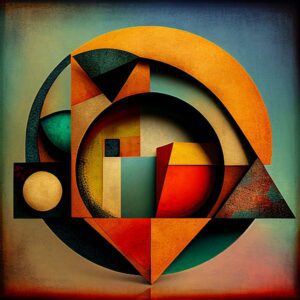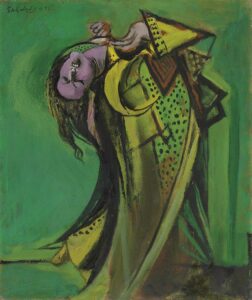In the tapestry of modern art, existentialism weaves a profound narrative that challenges our perceptions of existence.
It’s a philosophy that delves into the human condition, questioning our purpose and the essence of being.
As we explore existentialism in modern art, we’ll uncover how artists express the struggle for meaning in a seemingly indifferent universe.
Their canvases become arenas where complex emotions and existential inquiries play out, inviting us to ponder our own place in the world.
Origins Of Existentialism In Modern Art
The seeds of existential thought in art were sown in the fertile ground of the 19th century when artists began to express the subjective experience over objective reality.
This shift mirrored the philosophical inquiries of figures like Søren Kierkegaard and Friedrich Nietzsche.
Creators in disciplines ranging from painting to filmmaking have explored existential themes.
Each medium offers a unique lens through which to examine the human condition.
Our focus is how filmmakers use the visual and auditory storytelling power of cinema to jump into existential concerns.
- For example, modern art movements such as Surrealism and Abstract Expressionism are deeply rooted in existential thought. The former, through dream-like imagery that challenges reality,
- The latter, by conveying raw, personal emotion on the canvas.
These movements have set the stage for contemporary artists and filmmakers who weave existential threads into their works.
We’ve watched as they reject traditional narratives in favor of exploring what it means to exist within an frequently indifferent cosmos.
In cinema, filmmakers like Ingmar Bergman and Jean-Paul Sartre have expressed existential themes through poignant narratives and complex characters.
Their films often focus on individual angst in the face of an incomprehensible world.
- The Seventh Seal is a striking example, presenting an allegorical tale of a knight questioning faith and existence amidst the Black Death,
- Sartre’s influence reaches beyond his writings, impacting the thematic choices of filmmakers who contemplate existence on screen.
These artists have paved the way for later directors who challenge viewers with existential questions.
Modern filmmaking frequently employs narrative ambiguity, leaving space for audiences to draw their own meaning.
As such, existentialism continues to shape modern art, with each era presenting its unique interpretations and musings on life’s fundamental questions.
Through the exploration of existentialism, artists offer us a mirror – reflecting the timeless quest for purpose and understanding amidst the chaos of existence.
Key Philosophical Concepts In Existentialism
Existentialism delves deep into the human condition, examining our existence in a world that often seems both chaotic and indifferent.
At the heart of this philosophy lie several concepts that challenge us to find meaning amidst the apparent meaninglessness.
Freedom and Choice – We believe that existentialism places immense emphasis on the individual’s freedom and the weight of choice.
Every decision we make contributes to shaping our identity, casting a long shadow of responsibility over our actions.
Films such as The Seventh Seal reflect this tension between free will and the search for meaning in a seemingly arbitrary world.
The Absurd – The
Our recognition of this discord is beautifully depicted in works like Waiting for Godot, where the futility of the search for inherent meaning becomes evident.
- Existence Precedes Essence – This cornerstone concept suggests that humans first exist without any given purpose or essence, and only later define themselves through actions and choices. In Nausea, characters grapple with the profound angst that accompanies the realization of this existential freedom.
Alienation and Isolation – Alienation is a recurring theme in existential thought, underscoring our sense of disconnection from others, the world, or even oneself.
Taxi Driver explores this isolation, showcasing the protagonist’s struggle to find a place in a society he finds alienating.
In the canvas of modern art and filmmaking, artists and directors become philosophers – probing and questioning these existential themes.
They draw us into a world where characters and visual experiences resonate with the raw authenticity of the human experience.
Life, through the existential lens, isn’t about finding clear answers.
It’s about confronting the questions that make us profoundly human.
Existential Themes And Motifs In Modern Artworks
In the realm of modern art, existential themes are woven into the very fabric of the artistic tapestry.
Artists wield their brushes and lenses as tools to explore the depths of human experience – each stroke and scene a testament to the search for meaning in a seemingly indifferent universe.
- The existential motif of isolation is captured poignantly in Edward Hopper’s Nighthawks, where the sparse interaction and vacant stares evoke a sense of profound loneliness.
- Paintings like The Scream by Edvard Munch palpably convey the anguish and existential dread that lie at the heart of human vulnerability.
Filmmakers also jump deep into existential narratives, crafting visual stories that question our very existence.
In the film Blade Runner, we’re immersed in a world where the line between human and artificial life becomes blurred, prompting us to question the essence of our own humanity.
- Themes of freedom and self-determination are explored through the characters’ struggles to define themselves against a backdrop of societal and technological constraints.
Moving beyond still images to the dynamic arena of film, we encounter Andrei Tarkovsky’s Stalker.
This enigmatic tale utilizes long takes and a haunting atmosphere to engage with existential concepts of hope, faith, and the quest for a life imbued with meaning.
- The absurd is illustrated through the protagonists’ journey towards a place that may grant their deepest wishes, yet its very existence remains uncertain.
As we dissect these artworks and films, it’s clear that the essence of existentialism in modern art is not just reflected in thematic content but also in the stylistic choices made by the creators.
They employ composition, color, light, and narrative structure to mirror the complexities of existential thought, leaving us with profound impressions that linger far beyond the initial encounter.
Artists Who Embrace Existentialism In Their Work
Artists grappling with existential themes often jump into the human condition, exposing layers of meaning and emotion through their work.
From the bleak cityscapes of George Tooker to the raw brushstrokes of Willem de Kooning, existentialism in art is a powerful method of exploring profound truths.
These creators do more than craft images – they question existence and the role of individuals within it.
The allure of the existential can be seen in the films of Ingmar Bergman, whose narratives wrestle with morality, death, and spirituality.
Bergman’s masterpiece The Seventh Seal vividly captures the anguish of a medieval knight confronted by the silence of God amid the horrors of the plague.
Similarly, his film Persona invites viewers to contemplate the complexities of identity and human connection.
In literature, Franz Kafka’s novels embody existential thought through surreal and often oppressive settings.
His characters face absurd and labyrinthine bureaucracies, revealing the alienation and despair that can arise from an incomprehensible world.
The Trial and The Metamorphosis remain enduring explorations of individual angst in the face of an indifferent universe.
Among visual artists, the following have made significant contributions to existential themes in their work:
- Jackson Pollock – expressing the subconscious through abstract expressionism.
- Francis Bacon – depicting the visceral and grotesque aspects of the human form.
- Alberto Giacometti – sculpting the fragility and isolation of the human experience.
These artists and creators embody the essence of existentialism by confronting the audience with profound questions about life, the self, and our place in the world.
Their work doesn’t just lay bare existential thought; it invites an active engagement, pushing us to consider our own answers to the enduring questions they raise.
Through their unique lenses, we’re offered a deeper understanding of the human experience, unbounded by easy explanations or definitive endings.
Impact And Influence Of Existentialism On Modern Art
Existentialism’s reach extends far beyond just the canvases and sculptures of visual artists.
It has left a profound mark on the way we create and interpret modern art across various mediums.
In the realm of contemporary visual arts, existentialist themes have led artists to focus on the individual, often isolating figures to highlight their personal struggles.
This internal focus shifts the narrative from collective experiences to intensely personal journeys.
Abstract Expressionism, with its spontaneous brush strokes and powerful color fields, mirrors existential ideas by emphasizing the act of creation as a form of personal authenticity.
Existentialism In Film: A Cinematic Journey
Cinema, another major beneficiary of existential thought, explores the ambiguity and complexity of human existence.
Films are crafted with an emphasis on character psychology and moral dilemmas, embracing the lack of clear-cut answers that existentialism presents.
This introspective approach helps us understand characters on a profound level, often leaving us to ponder long after the credits roll.
For instance:
- Wild Strawberries navigates through the life of an aging man,,
- Blade Runner confronts the nature of humanity,,
- The Seventh Seal deals with the search for meaning amidst mortality.
By delving into the subconscious and confronting fears and desires, filmmakers like Bergman and Ridley Scott use their platforms to pose existential questions to a broad audience.
The Legacy Of Existential Literature
Literature provides a fertile ground for exploring existentialism through complex characters and narrative layers.
Writers such as Samuel Beckett and Albert Camus use their novels and plays to express the disconnectedness of people from the world around them.
Through their characters, who frequently confront the absurdity of their existence, they force readers to consider their own place in the universe.
Beckett’s Waiting for Godot and Camus’s The Stranger are landmarks of existential literature, highlighting themes of absurdity, freedom, and isolation.
Our ongoing exploration of existentialism illustrates that modern art’s embrace of these themes is not just a fascination but a meaningful dialogue.
Whether it’s on the screen, in the pages of a book, or on the walls of a gallery, the impact of existentialism on modern art challenges audiences to engage with the profound layers of the human condition.
What Is Existentialism In Modern Art – Wrap Up
We’ve seen that existentialism’s profound dialogue with the human condition resonates deeply in modern art.
Our exploration reveals a landscape where artists dare to question the essence of existence through their unique mediums.
Whether it’s the abstract expressionist’s canvas that speaks to personal authenticity or the filmmaker’s lens that frames life’s moral dilemmas, the impact is undeniable.
Literature too weaves this philosophical thread, presenting characters and narratives that mirror our own search for meaning.
This embrace of existentialism invites us to ponder our place in the world, ensuring that the conversation between art and audience remains as relevant and vibrant as ever.
Frequently Asked Questions
What Is Existentialism In Art?
Existentialism in art is a movement where artists reflect on human existence, emphasizing themes like individuality, freedom, and the search for meaning.
It’s often portrayed through narrative complexity and abstract expressionism.
How Does Existentialism Manifest In Literature?
In literature, existentialism is presented through complex characters and multilayered narratives.
Writers explore the sense of disconnection individuals often feel towards the world, highlighting personal struggles and internal dilemmas.
Can You Find Existential Themes In Films?
Yes, existential themes are prevalent in films.
They are explored through character psychology, moral dilemmas, and plotlines that pose profound existential questions to the audience.
How Do Visual Artists Convey Existential Ideas?
Visual artists often convey existential ideas through abstract expressionism, focusing on personal authenticity and the individual experience.
They may use colors, shapes, and forms to express emotions and deeper philosophical concepts tied to existence.
Why Are Existential Themes Important In Modern Art?
Existential themes are important in modern art as they initiate a meaningful dialogue.
They challenge audiences to engage with deeper layers of the human condition and reflect on personal freedom, responsibility, and the search for meaning in life.










